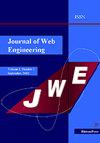一种基于DBSCAN的网络抓包数据对齐方法
IF 0.7
4区 计算机科学
Q4 COMPUTER SCIENCE, SOFTWARE ENGINEERING
引用次数: 0
摘要
本文研究了基于工业网络环境的PLC设备之间的数据包对齐和一致性问题,旨在保证从发送端到接收端的数据包的完整性和准确性。为了实现这一目标,我们提出了一种将DBSCAN聚类算法与3-sigma原理相结合的异常检测方法,以识别和处理传输过程中可能出现的异常数据包。通过比较发送端和接收端之间的数据,并基于时间戳和数据内容进行分析,验证了网络环境下数据包的一致性。实验结果表明,该方法能有效地检测和纠正丢包或延迟抖动,从而提高了PLC设备间通信的可靠性和数据传输的一致性。本文提出的方案能够更快、更精确地识别丢包和时延,并能很好地适应各种网络负载情况。进一步的实验分析表明,该方法在降低误报率和误报率方面都有较好的效果,并且具有良好的可扩展性,适用于其他工业自动化场景的数据对齐和一致性验证。最终,这种新颖的解决方案为网络环境中设备之间的数据传输提供了稳定性和准确性。本文章由计算机程序翻译,如有差异,请以英文原文为准。
A Data Alignment Method for Network Packet Capture Based on DBSCAN
This paper investigates the issues of packet alignment and consistency among PLC devices based on industrial network environments, aiming to ensure the integrity and accuracy of packets from sender to receiver. To achieve this goal, we propose an anomaly detection method that combines the DBSCAN clustering algorithm with the 3-sigma principle to identify and handle abnormal packets that may occur during transmission. By comparing the data between the sending and receiving ends, and analyzing based on timestamps and data content, we validate the alignment of packets in the network environment. Experimental results demonstrate that the proposed method effectively detects and corrects packet loss or delay jitter, thereby enhancing the reliability of communication between PLC devices and the consistency of data transmission. The scheme presented in this paper enables quicker and more precise identification of packet loss and delays, adapting well to various network load conditions. Further experimental analysis indicates that this method excels in reducing both false positive and false negative rates, and it exhibits good scalability, making it applicable to data alignment and consistency verification in other industrial automation scenarios. Ultimately, this novel solution provides stability and accuracy for data transmission among devices in a network environment.
求助全文
通过发布文献求助,成功后即可免费获取论文全文。
去求助
来源期刊

Journal of Web Engineering
工程技术-计算机:理论方法
CiteScore
1.80
自引率
12.50%
发文量
62
审稿时长
9 months
期刊介绍:
The World Wide Web and its associated technologies have become a major implementation and delivery platform for a large variety of applications, ranging from simple institutional information Web sites to sophisticated supply-chain management systems, financial applications, e-government, distance learning, and entertainment, among others. Such applications, in addition to their intrinsic functionality, also exhibit the more complex behavior of distributed applications.
 求助内容:
求助内容: 应助结果提醒方式:
应助结果提醒方式:


